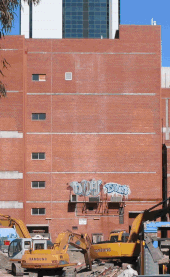Term: Demolition
Demolition Techniques
– Manual demolition methods
– Use of hydraulic equipment, cranes, and excavators
– Wrecking balls for masonry structures
– Rotational hydraulic shears and silenced rock-breakers for wood, steel, and concrete
– Flame cutting as a dangerous method replaced by shears
– Inside-out method for tall concrete buildings
– Wet demolition using fire hoses to control dust
– Loaders and bulldozers equipped with rakes for ramming walls
– Vérinage technique in France for weakening supports and promoting collapse
– Computer-controlled hydraulic jacks for safe and environmentally friendly demolition
– Hoe rams and hydraulic shears for bridge demolition
Building Implosion
– Use of explosives for large buildings, chimneys, bridges, etc.
– Ensuring the structure falls into its own footprint
– Risks of flying debris and damage to neighboring structures
– Potential instability and un-detonated explosives in partial failures
– Air overpressure causing shock waves and damage to surrounding buildings
– Controlled implosion as a last resort when other methods are impractical
– Increasing frequency of large building demolitions worldwide
– Example of J. L. Hudson Department Store and Addition implosion
– Spectacular but dangerous method
– Massive housing projects of the 1960s and 1970s being leveled
Preparation for Demolition
– Cleanup, quality standards, and phrasing improvement needed
– Ensuring proper preparation for implosion to avoid disasters
– Expert supervision to minimize risks and ensure safety
– Potential dangers of unstable structures and unexploded explosives
– Impact of shock waves and flying debris on onlookers and surroundings
– Controlled implosion as a method commonly associated with demolition
– Increasing demolition of large buildings globally
– Example of the tallest steel-framed building imploded (J. L. Hudson Department Store and Addition)
– Need for careful planning and consideration of cost-effectiveness
– Destruction of housing projects from the 1960s and 1970s
Notable Demolition Projects
– Demolition of the Myer Building in Perth, Western Australia
– Partially demolished house in Qormi, Malta
– Cooling towers of the Athlone Power Station in Cape Town, South Africa
– Demolition of a house in Argos, Greece
– Tallest planned demolition of 270 Park Avenue in New York City
– Fred Dibnah’s manual method of chimney demolition in Great Britain
– Building implosion at the former brewery Henninger in Frankfurt, Germany
– Demolition of the New Haven Coliseum in Connecticut
– Importance of controlled implosion for tall structures in dense urban areas
– Risks of failed demolitions and damage to neighboring structures
Other Related Topics
– Progressive collapse technique in demolition
– Clean-up process after demolition
– Deconstruction as an alternative to minimize landfill waste
– Related topics such as construction waste and demolition waste
– Excavator ram guards for equipment protection
– House demolition as a military tactic
– ICE demolition protocol as a specific procedure
– References including articles, books, and interviews about demolition
Demolition (also known as razing, cartage, and wrecking) is the science and engineering in safely and efficiently tearing down of buildings and other artificial structures. Demolition contrasts with deconstruction, which involves taking a building apart while carefully preserving valuable elements for reuse purposes.





For small buildings, such as houses, that are only two or three stories high, demolition is a rather simple process. The building is pulled down either manually or mechanically using large hydraulic equipment: elevated work platforms, cranes, excavators or bulldozers. Larger buildings may require the use of a wrecking ball, a heavy weight on a cable that is swung by a crane into the side of the buildings. Wrecking balls are especially effective against masonry, but are less easily controlled and often less efficient than other methods. Newer methods may use rotational hydraulic shears and silenced rock-breakers attached to excavators to cut or break through wood, steel, and concrete. The use of shears is especially common when flame cutting would be dangerous.
The tallest planned demolition of a building was the 52-storey 270 Park Avenue in New York City, which was built in 1960 and torn down in 2019–2021 to be replaced by 270 Park Avenue.
